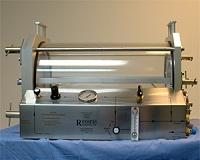 |
College Park MD (SPX) Apr 08, 2011 A new drug delivery device designed and constructed by Jie Chen, Thomas Cesario and Peter Rentzepis promises to unlock the potential of photosensitive chemicals to kill drug-resistant infections and perhaps cancer tumors as well. Photosensitive chemicals are molecules that release single oxygen atoms and chemical radicals when illuminated. These radicals are very active chemically, and can rip apart and destroy bacteria, said Peter Rentzepis, a professor of chemistry at University of California, Irvine. Yet photosensitive chemicals are not approved for use in the United States, and used relatively rarely in Europe. This is because they are highly toxic and difficult to activate beneath the skin, since light only penetrates a few millimeters into the body. Photosensitive chemicals also cause severe reactions, including headaches, nausea, and light sensitivity for 30 days. They kill healthy cells as well as bacteria. Although several have therapeutic potential, they are too toxic for human use by injection. The researchers solved this problem with an optical fiber-based device that can deliver very small amounts of photosensitive chemicals to internal organs with pinpoint accuracy. The device consists of three components. The first is an imaging component similar to the charge coupled devices (CCDs) in digital cameras. It enables a physician to guide the device to the infection. A 1-millimeter-diameter flexible optical fiber attached micro sized high-power LED or laser diode provides the light for the CCD. Once the physician positions the device, the same light source shines with greater intensity to activate the medicine. The third component is a hollow tube connected to a syringe of medicine to deliver the medicine to the infection. Rentzepis adds glycol, a thickening agent used in surgical soaps, to keep the medicine from spreading to healthy cells. Pulling the syringe backwards creates a vacuum that sucks up any remaining chemical after the procedure. "We can insert the instrument through the nose, bowels, mouth, or almost any opening and direct it where we want," Rentzepis said. "It lets us deliver very small amounts of these chemicals right to an infection or tumor, then remove them before they damage healthy cells." The researchers plan to test the device on animals with infections and cancer.
Share This Article With Planet Earth
Related Links American Institute of Physics Hospital and Medical News at InternDaily.com
 High Dose Of Oxygen Enhances Natural Cancer Treatment
High Dose Of Oxygen Enhances Natural Cancer TreatmentSeattle, Washington (SPX) Apr 5, 2011 A technique Michael Jackson reportedly used to prolong his youth is showing promise as a way to boost the effectiveness of a natural cancer remedy. An environment of pure oxygen at three-and-a-half times normal air pressure adds significantly to the effectiveness of a natural compound already shown to kill cancerous cells, researchers at the University of Washington and Washington State Universi ... read more |
|
| The content herein, unless otherwise known to be public domain, are Copyright 1995-2010 - SpaceDaily. AFP and UPI Wire Stories are copyright Agence France-Presse and United Press International. ESA Portal Reports are copyright European Space Agency. All NASA sourced material is public domain. Additional copyrights may apply in whole or part to other bona fide parties. Advertising does not imply endorsement,agreement or approval of any opinions, statements or information provided by SpaceDaily on any Web page published or hosted by SpaceDaily. Privacy Statement |